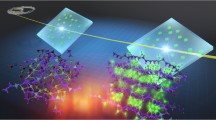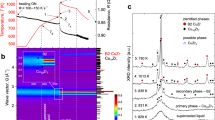Abstract
THE nucleation of phase separation in bulk solids remains one of the more elusive phenomena in both experimental and theoretical terms1. Experimentally, the difficulties centre on the problem of gaining detailed structural information about the small composition fluctuations from which the precipitate develops. Theoretically, progress has been made in calculating stable microstructures in simple materials such as the rare gases2 and amorphous metals3 as well as identifying transient clusters in liquids which are precursors to long range order and thus may act as nucleation embryos4. However, it remains a formidable problem to relate such calculations to the microstructure of a multicomponent solid or liquid. The most readily observed physical property of nuclei is their ability to facilitate growth of a new phase in appropriate conditions. Consequently, the study of the growth process immediately following nucleation is the most accessible though indirect method of inquiry into nucleation. It is, however, often difficult to follow the very early stages of growth either because it occurs too rapidly, or because the size or total mass of the precipitate falls outside of the conventional range of structural techniques. We report here the striking effects of nucleation as revealed by a neutron small angle scattering study (SANS) of a glass ceramic (2MgO, 2Al2O3, 5SiO2+10% TiO2 nucleating agent) during the early stages of growth of the precipitate. As a result of the continuous viscosity–temperature relationship, the rate of phase separation in glasses can be put on a favourable time-scale to follow the kinetics of growth simply by working at the appropriate temperature. Also as will be evident below, neutron small angle scattering provides important advantages in following the growth of precipitates in bulk. Three particular advantages have been exploited. (1) The range in scattering vector Q(Q = (4π sin θ)/λ) which it is possible to study includes the region around Q = 0.005 Å−1 which generally falls between the scope of X-ray small angle scattering and light scattering measurements; (2) the low absorption of neutrons even at long wavelengths (∼10 Å) allows the easy investigation in transmission of a bulk glass which is heated directly in the neutron beam; and (3) the precipitating phase (an aluminium titanate solid solution) is rich in titanium atoms, and the negative scattering length of titanium ensures that there is good scattering contrast between the precipitate and the host silicate glass. All the experiments were carried out at the Institut Laue–Langevin on the D11 spectrometer5.
This is a preview of subscription content, access via your institution
Access options
Subscribe to this journal
Receive 51 print issues and online access
$199.00 per year
only $3.90 per issue
Buy this article
- Purchase on Springer Link
- Instant access to full article PDF
Prices may be subject to local taxes which are calculated during checkout
Similar content being viewed by others
References
Reiss, H. in Precipitation, 213–223 (Chemical Society, London, 1976).
Hoare, M. R. & McInnes, J. in Precipitation, 13–24 (Chemical Society, London, 1976).
Bryant, C. L. in Precipitation, 25–33 (Chemical Society, London, 1976).
Bernal, J. D. Nature 181, 68 (1960).
Schmatz, W., Springer, T., Schelten, J. & Ibel, K. J. appl. Crystallogr. 7, 96–116 (1974).
Lazlaz, G., Guyot, P. & Kostorz, G. J. Phys., C7, Suppl. No. 12, 38, 406–410 (1977).
Lazlaz, G., Kostorz, G., Roth, M., Guyot, P. & Stewart, R. J. Phys. Stat. Sol. (a) 41, 557–583 (1977).
Walton, W. J. Nucleation, (ed. Zettlemoger, A. C.) 1–69, (Marcel Dekker, New York, 1969).
Author information
Authors and Affiliations
Rights and permissions
About this article
Cite this article
WRIGHT, A., TALBOT, J. & FENDER, B. Nucleation and growth studies by small angle neutron scattering and results for a glass ceramic. Nature 277, 366–368 (1979). https://doi.org/10.1038/277366a0
Received:
Accepted:
Issue Date:
DOI: https://doi.org/10.1038/277366a0
This article is cited by
-
Nucleation and crystallization studies of a basalt glass-ceramic by small-angle neutron scattering
Journal of Materials Science (1983)
-
Controlled nucleation and quasi-ordered growth of ice crystals from low temperature electrolyte solutions
Nature (1982)
Comments
By submitting a comment you agree to abide by our Terms and Community Guidelines. If you find something abusive or that does not comply with our terms or guidelines please flag it as inappropriate.



